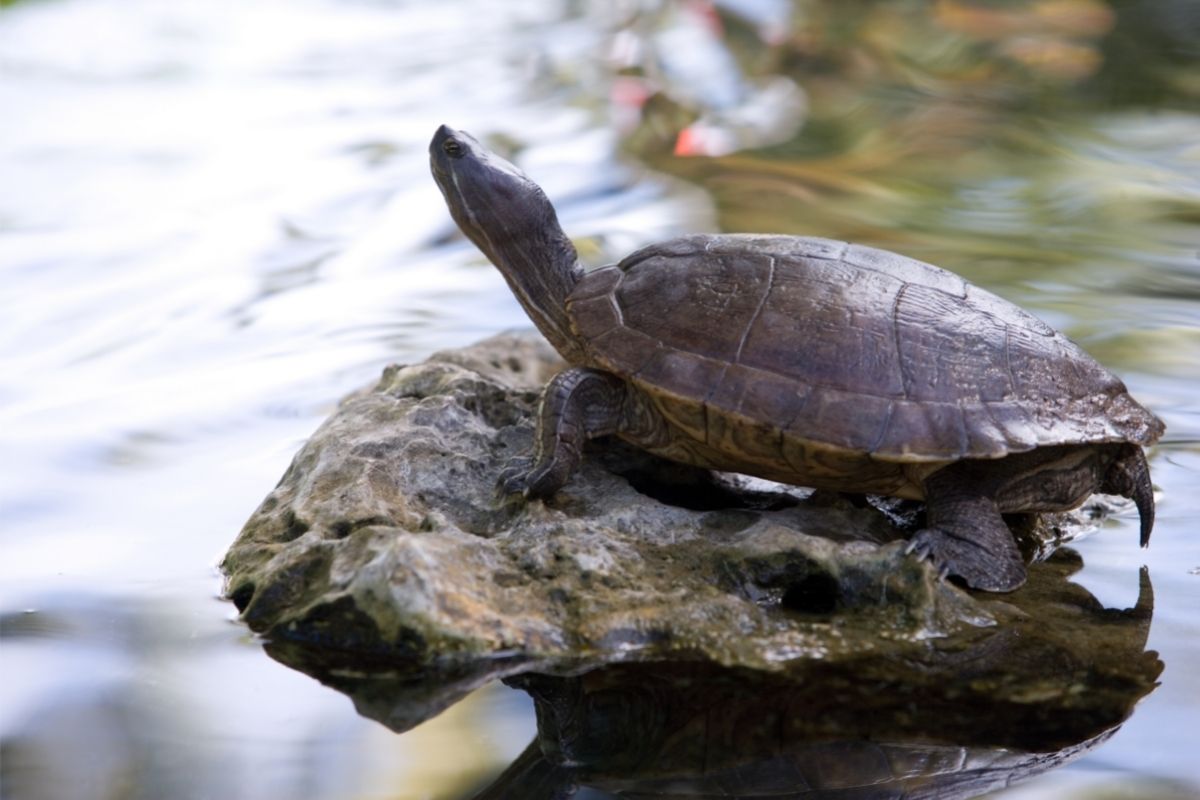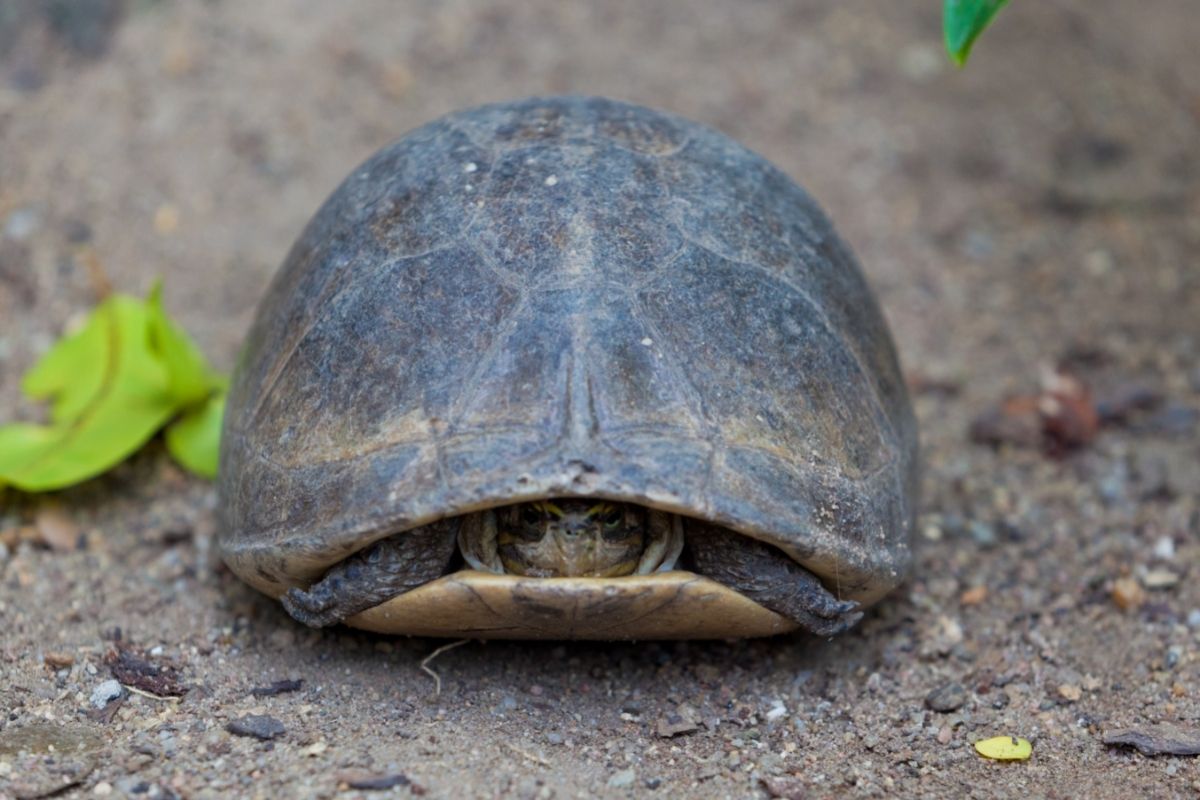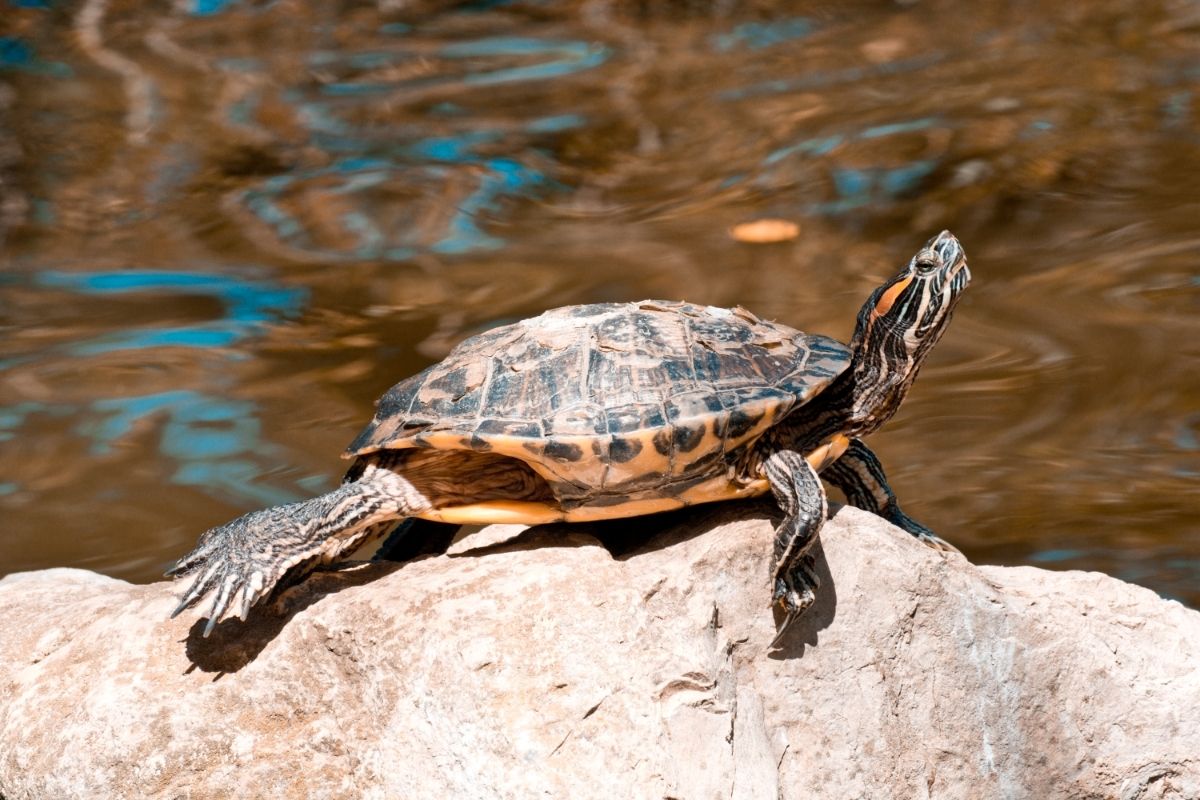Humans and turtles both enjoy spending time sitting in the sunshine. But while for people we call this sunbathing, in turtles, this habit is known as basking. Basking is when a turtle heads to a sunny spot of land and stretches out in the heat.
Basking is beneficial for the health of the turtle, regulating body temperature, killing germs, and producing vitamin D. A healthy and happy turtle will bask for several hours a day.
Learn all about basking, why turtles do it, why they aren’t doing it, and behaviors to be aware of with this guide.
Why Do Turtles Bask?
As a cold-blooded animal, the temperature of the turtle is determined by its surroundings. They can’t regulate their own body temperature as mammals do.
This means that if they’re in a hot environment, they get hot. But if they spend too long in the cold, they can get very cold.
For turtles, basking is an opportunity to warm up and regulate their internal body temperature. This is why many turtles spend time swimming and then time basking on land.
The water helps them to cool down, while basking will warm them back up. And it isn’t just about comfort. Being at the right temperature ensures their metabolism is functioning efficiently.
But internal temperature is just one of the reasons why basking is so important for turtles.
Turtles bask in the sunlight, not just in any warm spot they can find. The UV rays provided by the sun are essential to the health of the turtle.
UVB light exposure encourages the production of vitamin D3, which improves how the body absorbs and uses calcium. Calcium is vital for bone health. By basking in the sun, turtles are doing what they can for a stronger, healthier body.
Another important reason for basking might be a little surprising — it helps turtles dry out. Parasites and fungal infections thrive in damp spaces and can cause a turtle to fall ill.
When the turtle basks, these pockets of moisture heat and dry, destroying the habitat the infection needs to live. Basking is more than just a chance for a turtle to soak up the sun. It’s essential for their health and well-being.
How Long Do Turtles Bask For?

A turtle can bask between 2 and 8 hours every day. This is quite a large time range, as it’s dependent on both the species and the conditions.
Some species of turtle choose to bask for large parts of the day, while others will only make brief appearances on land. Turtles are pretty good at knowing when they’ve spent enough time basking to absorb all the heat and UV they need.
Before you start worrying about how long (or how little) your turtle is basking, it’s important to know what’s right for the species. A semi-aquatic turtle, such as the red-eared slider, might spend less time basking than a terrestrial box turtle.
Conditions can also affect how long a turtle basks for. If the light isn’t providing them with enough heat or UVB, they may spend more time basking to try and soak it all up.
In an enclosure, you should ensure your turtle is always receiving the amount of light they need.
Many turtles like to keep a routine, so you might notice that they come to bask at roughly the same time every day.
However, it is essential to be aware of any changes to your turtle’s basking habits. It won’t always be a problem – sometimes turtles enjoy shaking up their routine – but too much or too little basking can be a sign that your turtle is ill.
The Importance Of Basking Lights For Your Pet Turtle
In the wild, turtles are exposed to UV lighting throughout the day. And when they need more of it, they can climb onto land (or up their favorite rocks) and bask in a warm patch. In an enclosure, they don’t have access to the same kind of light.
To compensate for the lack of natural lighting, a basking lamp is used. A basking lamp can emit both UVA and UVB rays, as well as warm up a chosen area of the enclosure. A basking lamp provides a concentrated beam of light, which can be directed into a spot in the enclosure.
With a basking light, you have control over the exact conditions of the enclosure. Even if you place the tank in a sunny spot in the house, there’s a chance that on cloudy days, your turtle won’t see the sun. A basking light removes chance from the equation.
By installing a basking light, you also introduce a routine to your turtle’s day. Put the light on a timer, and the turtle will have a 24-hour cycle to build its day around. This will sync with their natural circadian rhythm.
Why Is My Turtle Basking So Much?
Some turtles love to bask and will spend many hours of the day outside the water. Basking in the warmth can regulate their internal body temperature and improve their metabolism.
It also provides them with UVB light, producing vitamin D that helps absorb calcium for a stronger shell. And basking dries out dark, damp patches where infections can thrive.
Turtles will spend much of the day in the water and climb onto the land occasionally to bask. However, at times you might notice your turtle is basking more than usual and rarely seems to spend any time in the water.
It can be tricky to spot when your turtle is basking more. Familiarize yourself with their behavior patterns so you notice any changes.
Below are some potential causes for excess basking.
The Water Is Too Cold Or Too Hot
One of the main reasons a turtle basks is to regulate its body temperature. A sunny basking spot can warm them up after a swim in cooler water.
If they’re spending excess time on the basking platform, it might be that they need more warmth to compensate for cold water.
Alternatively, the water could be too hot. If the basking platform is cooler than the water, they may need to switch how they spend their day.
To avoid this, be sure to monitor the temperature of the water to ensure it’s just right for your pet turtle.
The Water Chemistry Has Changed
If your turtle now seems to prefer to spend time on land, it might be that the water chemistry has changed. Turtles are sensitive to these changes and will avoid spending time in an environment that isn’t right.
The pH level of a turtle tank should be somewhere between 6 and 8. The ammonia and chlorine levels should both be at 0, and the nitrite level should be between 0 and 0.5 parts per million. The nitrate levels should be below 40 ppm.
Use a testing kit to ensure the water chemistry is in balance. If not, you should clean the tank and bring the levels back to normal.
Your Turtle Has A Respiratory Illness
Respiratory infections are common causes of excess basking, preventing the turtle from swimming as it needs to.
If you suspect your turtle has a respiratory infection, check for these signs: mucus discharge around the nose, eyes, or mouth; swollen or discolored eyes, difficulty breathing, coughing, or sneezing; and problems swimming.
Respiratory infections can also result in a change of behavior. You might notice your turtle is sluggish and confused or, alternatively, hyperactive.
Digestive Or Other Illness
A turtle that’s struggling to digest its food might spend more time basking because it’s finding swimming difficult. This will often be accompanied by a change in appetite.
Contact a vet if you suspect your turtle is unwell, no matter the cause. They can provide medication and advice to get your turtle swimming again.
Pregnancy
It’s possible your turtle is pregnant! Pregnant females have different needs during gestation, but when they’re close to laying, they start to spend more time on land.
Many turtles build nests on land to lay their eggs, so stick close to the shore when they suspect it’s almost laying time.
There is a trick you can use to check for a pregnant turtle. Pick your turtle up, and feel under her hind legs for small, hard lumps. These are the eggs.
Territorial Tankmates
Turtles are generally pretty good at living together, and it is possible to have several turtles in the same tank. However, there’s no guarantee they’ll get along. Just as with humans, sometimes turtles have personality clashes.
And if you keep a mixed-gender tank, you might find a male starts to bother a female. It’s important to keep an eye out for territorial behaviors, such as bullying, chasing, or fighting.
Fights and arguments might cause one turtle to retreat to the basking area, where it can hide away from the aggressor.
A bigger tank can prevent territory disputes, but if you already have an aggressive turtle, it should be removed before the problem escalates.
Why Isn’t My Turtle Basking?

Turtles need to bask to maintain their health and body temperature. If your turtle has stopped basking, it’s likely that something is wrong. Take a look at these reasons below, which might explain why your turtle isn’t basking.
The Basking Area Isn’t Suitable
As cold-blooded animals, turtles need heat from outside sources to regulate their body temperature. This means they have to regularly bask, to raise their internal temperatures.
However, they also return to the water to cool down. When the basking area is too hot, your turtle might need to stay in the water.
The basking area should be at around 85 to 95 degrees F. If it’s too hot, the turtle will feel uncomfortable and retreat to cool water. If it’s too cold, then your turtle will grow sluggish and won’t feel tempted by the basking area.
Monitor the temperature using a thermometer, and adjust accordingly. You may need to move the basking lamp further back or closer to maintain optimal temperature.
Make sure to turn the basking lamp off overnight. To make this easier, put the lamp on an automatic timer.
Your Turtle Is Feeling Stressed Or Scared
The basking area should be a safe retreat for your turtle. In the wild, a basking turtle can be vulnerable to predators. Because of this, they’ll only bask when they feel relaxed.
Turtles are often shy, and it can take some time for them to adjust to a new environment. If you’ve just bought a turtle home, don’t be surprised if they aren’t basking right away.
Give the turtle some time to get comfortable in its new home, and you should see it start to bask.
However, if you’ve had your turtle for a while and it suddenly stops basking, this might be a sign that something is causing stress.
Excess noise and handling can lead to stress for a turtle and cause them to stay in the water. Try and remove any external factors that might be upsetting your turtle.
Install some privacy screening around the basking area so the turtle has a place to hide even when it basks.
It’s Pregnant
Yes, pregnancy can lead to both a lot of basking and no basking at all. Pregnancy can cause some strange behaviors as your turtle adjusts to the new experience.
This might lead them to stay away from the basking area for no apparent reason. Turtles typically lay between three and six weeks after mating, so the strange behavior shouldn’t last for long.
However, there might be a simpler explanation for your turtle spending all its time in the water: your turtle is basking when you’re not around.
Some turtles only need to spend a few hours basking, and it might just be something they do when no one is there. If your turtle doesn’t seem stressed or upset, and the temperature is right, there’s a good chance your turtle prefers to bask alone.
Can Turtles Go For Long Without Basking?
A turtle will typically bask every day, but it can survive without basking for several weeks. However, this will cause their health to decline. Even a couple of days without basking can lead to some serious health repercussions.
The lack of UV light can cause weakness in bones and the shell, as the turtle can’t utilize calcium correctly.
Basking is good for a turtle and an essential part of a healthy turtle lifestyle. It’s also enjoyable to watch! Encourage basking by installing a basking light and platform and creating a comfortable environment for your turtle to relax.
Frequently Asked Questions About Turtle Basking
Humans might like to sunbathe, but there’s plenty about basking that can seem a little unusual. Take a look at these basking FAQs to find out more.
Why Do Turtles Stretch Their Legs When They Bask?
A turtle typically basks by laying on its plastron (underside), and stretching out its head and neck. You might also spot your turtle stretching out its limbs. This presents a wider surface area for UV and heat to penetrate.
Why Do Turtles Stack?
If you have several turtles in a tank, you might notice that they bask in a pile. In a pile, the turtles can receive higher ground for better sunlight, and generate more warmth.
Climbing on top of your friends may not seem like the smartest way to bask, but it is actually beneficial for all turtles involved. Turtles tend to stack when there’s a lack of good basking spots.
Why Is My Turtle Basking With Its Head Lowered?
When a turtle basks, it likes to spread out to absorb as much heat and sunlight as possible. Basking with the head down can be a sign that the turtle is feeling unwell.
Basking with the head down isn’t always something to worry about. It’s often just the sign of a sleepy turtle, relaxing in a sunny spot.
But if head-down basking is accompanied by mucus around the nose, mouth, or eyes, trouble breathing, or trouble swimming, your turtle might have an infection. Speak to a vet for correct treatment and advice.
Why Is My Turtle Basking At Night?
Basking at night is a behavior sometimes seen in turtles in captivity. If your turtle is choosing to bask at night, the reason is often simply that you’ve left the basking light on.
The basking light is how your turtle navigates the day. If it’s on, they won’t know that it’s nighttime.
It’s recommended to turn the basking light off overnight, so the turtle experiences the same amount of day and night it would in the wild.

